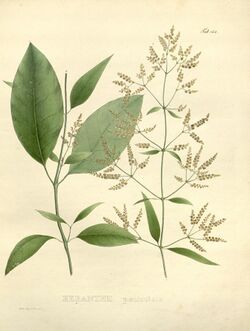Biology:Hebanthe erianthos
| Suma | |
|---|---|

| |
| Scientific classification | |
| Kingdom: | Plantae |
| Clade: | Tracheophytes |
| Clade: | Angiosperms |
| Clade: | Eudicots |
| Order: | Caryophyllales |
| Family: | Amaranthaceae |
| Genus: | Hebanthe |
| Species: | H. erianthos
|
| Binomial name | |
| Hebanthe erianthos (Poir.) Pedersen
| |
| Synonyms[1] | |
| |
Hebanthe erianthos (many synonyms, including Iresine erianthos and Pfaffia paniculata),[1] known as suma or Brazilian ginseng, is a species of plant in the family Amaranthaceae. The specific epithet is also spelt "eriantha", although the basionym is Iresine erianthos.[2]
The root of this rambling ground vine found in South America is used traditionally as a medicine and tonic. Nicknamed "para tudo" in Brasil, which means "for everything", suma is a traditional herbal medicine.[3] The indigenous peoples of the Amazon region have used suma root for generations for a wide variety of health purposes, including as a general tonic; as an energy, rejuvenating, and sexual tonic; a calming agent; to treat ulcers; and as a cure-all for at least 300 years.[4]
The root contains phytochemicals including saponins (pfaffosides),[5] pfaffic acid, beta-ecdysterone, glycosides, and nortriterpenes.[4]
See also
- List of plants of Cerrado vegetation of Brazil
References
- ↑ 1.0 1.1 "Hebanthe erianthos (Poir.) Pedersen". Plants of the World Online. Royal Botanic Gardens, Kew. https://powo.science.kew.org/taxon/urn:lsid:ipni.org:names:1109939-2.
- ↑ "Hebanthe erianthe (Poir.) Pedersen". The International Plant Names Index. https://www.ipni.org/n/1109939-2.
- ↑ Vieira, Roberto F. (1999) Conservation of medicinal and aromatic plants in Brazil. p. 152–159. In: J. Janick (ed.), Perspectives on new crops and new uses. ASHS Press, Alexandria, VA.
- ↑ 4.0 4.1 Leslie Taylor (2005). "The Healing Power of Rainforest Herbs". Tropical Plants Database. http://rain-tree.com/suma.htm#.Up5tcMTuLc8.
- ↑ "Triterpenoids from Brazilian Ginseng, Pfaffia paniculata" Jing Li, Atul N. Jadhav, Ikhlas A. Khan Tropical Plant Database
Wikidata ☰ Q15591411 entry
 |

